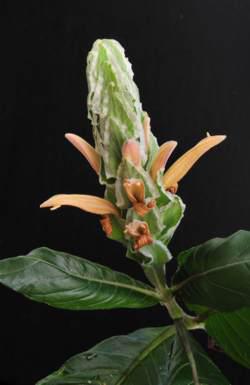Metarungia galpinii
Metarungia galpinii (Baden) Baden
Family: Acanthaceae
Common names: southern orange-lips
Introduction
Metarungia galpinii is a very rare and attractive garden plant that occurs mainly in the East London area in the Eastern Cape.

Description
Description
Metarungia galpinii is an evergreen, much-branched shrub with large and slightly glossy leaves from the base, reaching a height of 3m in gully bush, but does not grow quite as tall in open areas. Leaves are opposite, prominently veined, with a wooly midrib and margins with rounded teeth pointing forward.
Inflorescences are situated at the tips of spikes or on side shoots. Flowers are cream and tinged with pink and ochre.

Capsules are 2-locular with sparse hairs. The whole plant has a distinctive pungent smell. Flowering time is mainly in February to March, but occasionally blooms irregularly after heavy rain.
Conservation Status
Status
This plant is Red Listed as Endangered (EN) as it is known from only two locations, at one of which the population is declining due to expansion of an informal settlement. Although local authorities intervened to relocate the Nahoon Dam sub-populations, these plants were unfortunately lost, as the habitat to which they were relocated was not suitable for them. Hence, only two known locations for this species remain.
Distribution and habitat
Distribution description
Metarungia galpinii is known only from the East London district, in forest along rivers, below 500m.
Derivation of name and historical aspects
History
The genus Metarungia consists of three species and has a distribution range extending from Ethiopia through tropical East Africa southwards to the Eastern Cape. The name galpinii commemorates the collector E.E. Galpin, who first collected the plant on the banks of the Nahoon River in May 1912, and again in March 1929.
Metarungia galpinii is closely allied to M. longistrobus which has cone-like inflorescences. Metarungia galpinii differs in having larger sized leaves, flower spikes, bracts and flowers.
Ecology
Ecology
Metarungia galpinii has very long, remarkably tough roots and is able to withstand long periods of drought very well.
Uses
Use
Horticulture is the only known use for Metarungia galpinii as it makes an attractive garden specimen.
Growing Metarungia galpinii
Grow
Metarungia galpinii is easily propagated from either seed or cuttings.
Once the seeds have been shed from the capsules, use a tray and sow the seeds into free-draining seedling mixture to ensure that the young roots do not become waterlogged. Move the tray into the shade once the seeds start to germinate, as this is a shade-loving plant. Always ensure that you are able to keep the soil temperature up to encourage growth. Once the first proper leaves are produced, prick the young seedlings out and plant them into the ground where they will be growing permanently.
Take tip cuttings when plants are actively growing. Rooting takes place in 10-14 days if the bed is bottom-heated and there is a mist to keep the shoots cool. Young plants derived from cuttings usually flowers in their third year of growth.
References
- Baden, C. 1984. Metarungia , a valid name for Macrorungia auctt. (Acanthaceae). Kew Bulletin 39(3): 638.
- Baden, C. 1989. The Flowering Plants of Africa 40(2), Plate 1989: Metarungia galpinii.
- Baden, C. 1995. Acanthaceae. Flora of southern Africa 30,3. National Botanical Institute, Pretoria.
- Red List of South African Plants, http://redlist.sanbi.org
- http://www.sabonet.org.za/downloads/36_rare_plants/j.chapter6.1.pdf
Credits
Vathiswa Zikishe
Custodians of Rare and Endangered Wildflowers (CREW)
Images Tony Dold
March 2014
Plant Attributes:
Plant Type: Shrub
SA Distribution: Eastern Cape
Soil type:
Flowering season: Late Summer
PH:
Flower colour: Cream
Aspect:
Gardening skill:
Special Features:
Horticultural zones








Rate this article
Article well written and informative
Rate this plant
Is this an interesting plant?
User Comments
Ann Symons, South Africa
November 18, 2017 at 1:46 PMHello Vathiswa,
How nice to see that you're the author of this article!
Got to it via a post of Caroline Voget's about the other species in the genus. I have used a very similar plant (sourced from Mike Vivier when he had the nursery at Fancourt) Suspect it is family but not indigenous. It does well in a tricky garden on the first dune of Wilderness Leentjiesklip beach. Do visit the Facebook page "Indigenous flowering plants of Southern Africa' - we're all learning so much by being members.
High five!
Ann Symons (Outramps Crew till end 2014) - George
Login to add your Comment
Back to topNot registered yet? Click here to register.